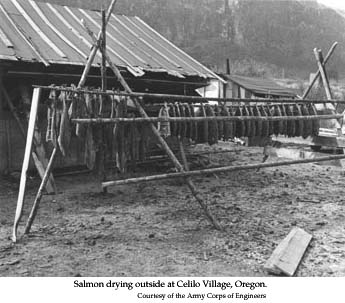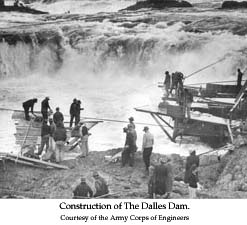The Dalles Dam was a battle of conservation for the Celilo Indians.
According to archeological digs before the completion of the Dalles Dam, the Indian people had been living at the site for over 11,000 years. The area had not only provided Celilo Indians with a place to live, it had also provided them a source of income with the fishing of abundant salmon in the river. Many Indians looked at the site as sacred. The construction of the Dalles Dam would not only put the economy of the Celilo Indians in jeopardy, it would also possibly exterminate their whole way of life.

Before white encroachment, the Celilo area known as The Dalles was part of trade routes that linked Indian peoples from as far north as Alaska and as far south as California. Celilo was a focal point where tribes from all over the northwest gathered to engage in trade, fishing, and social interaction.
The Celilo area continued to be a focal point for northwest Indians. In the 1920's the Yakima, Warm Springs, and Umatilla Indians joined the residents of Celilo residents to form the Celilo Fish Committee. This committee regulated the fishing activity and resolved conflicts between fishers from different tribes.
The Celilo Fish Committee was overseen by the chief of the Celilo Village, Chief Tommy Thompson. Chief Tommy Thompson took an active role in the fishing activities of the river. His presence was seen on a daily basis when he would delegate fishing locations and times for Indians wanting to fish the river. He had meetings with the fishers emphasizing the importance of conservation of the river. He would signal the fishermen when they could start and would signal again when they needed to stop and come in for the day. Chief Tommy Thompson's involvement in conservation of the river earned him the respect of Indians from other tribes.

The Great Depression brought many challenges to the Celilo Indians when Congress authorized funding for the Dalles Dam. Construction of the Dalles Damn would effectively flood Celilo Falls and parts of Celilo Village. Members of the Celilo Fish Committee protested the construction in official testimony before Congress. Congress ordered the Army Corps of Engineers to negotiate a settlement with the members of the Celilo Fish Committee and other Indians affected by the Dalles Dam. Most Indians, including Chief Tommy Thompson, felt no amount of money would be able to compensate them for what they would lose because of the dam.
Chief Tommy Thompson vocalized his concerns in a letter written to Jasper Elliott, Superintendent of the Warm Springs Reservation.
Celilo, Oregon |
The construction of The Dalles Dam was eventually completed and displaced residents of Celilo Village. Residents had no choice but to leave their homes of over 11,000 years and search for new place to work and live.
Celilo Village is only a small part of the struggle Columbia Basin Indians have faced over the course of federal dam building from the 1930's to the 1970's. These dams have been a major cause for salmon shortages and possible extinctions which in turn further jeopardize the livelihood of native and non-native fishermen alike. The construction of dams have evicted Indians from thousands of river miles and drowned their sacred lands beneath large reservoirs. Celilo Falls represents the sad legacy of The Dalles Dam, an effective execution of Indian legacy and life.